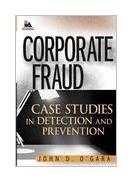|
||
podział tematyczny • wydawnictwa anglojęzyczne podział tematyczny Newsletter: • Zamów informacje o nowościach z wybranego tematu Informacje: • sposoby płatności i dostawy • kontakt • Cookies na stronie • Regulamin zakupów Napisz propresssp@gmail.com |
CORPORATE FRAUD CASE STUDIES IN DETECTION AND PREVENTIONO'GARA J.wydawnictwo: WILEY , rok wydania 2003, wydanie Icena netto: Real-world help for companies combating fraud - from major management fraud to fraudulent financial reporting From the author's more than thirty years of corporate auditing experience, Corporate Fraud features scores of useful case studies that illustrate the principles of numerous types of fraud and how to avoid them in your business. A must-have for all auditors, controllers, CFOs, and business managers, Corporate Fraud offers broad coverage of:
Table of Contents Chapter 1. Overview. Varieties of Fraud/Perspective. More Than Fraudulent Financial Statements. Emphasis: Recognition and Detection-Case Studies. Major Management Fraud Is Different. Chapter 2. Perspective (ACFE Studies). 1996 and 2002 ACFE Reports to the Nation. Breakdown of Estimated Total Occupational Fraud Loss by Major Category. Classifications. Chapter 3. Management Fraud against the Organization (General). Characteristics. Major Symptoms of Management Fraud. Opportunities Afforded by the System for Performance Accountability. Chapter 4. Red Flags of Management Fraud. Six Major Fraud Profiles-Common Elements. Red Flags of Management Fraud. Contrast with Nonmanagement Fraud. Bullet-Proof and Invisible Leads to Flaunting. Chapter 5. Fraud against the Organization (Corruption). Middlemen. Real Estate/Related Parties. Bribery-Contracting/Subcontracting/Leasing. Outsourcing. Mani pulation of Performance Bonuses/Co-opting Others. Chapter 6. Fraud against the Organization (Asset Misappropriation). Various General Accounting-Cycle Fraud Symptoms. Vendor Billings-False Invoices/Phantom Vendor (Shell Company). Other Disbursement Fraud. Inventory. Skimming/Cash Receipt Misappropriation Fraud. Chapter 7. Fraud for the Organization. Financial Reporting. Money Laundering/Illegal Practices. International Arena. Price-Fixing/Bid Rigging. Commercial Bribery. Chapter 8. Methodology: Detection/Investigation. Differences-Management versus Employee Accounting-Cycle-Type Fraud Detection/Investigation. Recognition/Detection. Detection/Investigation. Investigation. Chapter 9. CAAT Scans for Scams. Middlemen/Related Parties. Top-Down Forensic Monitoring. Telltale Debits of Misappropriation. Bank Accounts/Addresses. Chapter 10. Conclusion. Low Frequency of Detection/Prosecution versus Effective Prevention. Managerial as Well as Accounting Perspective. History: Good Old Days. Risk/Reward Dynamic. Thoughts on Recent Accounting Scandals. Appendix A: Practice Advisory 1210.A2-1: Identification of Fraud. Appendix B: Practice Advisory 1210.A2-2: Responsibility for Fraud Detection. Appendix C: Derivation: Management Non-Financial-Statement Fraud as a Percentage of Total Occupational Fraud Loss. Appendix D: Percentage of Total Occupational Fraud Loss Attributable to Management Fraud. Appendix E: KPMG Study. Appendix F: Classification: Management Fraud Categories. Glossary of Terms. Notes. Index. 202 pages Księgarnia nie działa. Nie odpowiadamy na pytania i nie realizujemy zamówien. Do odwolania !. |


